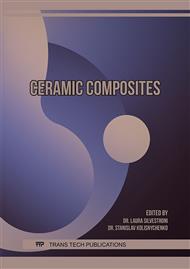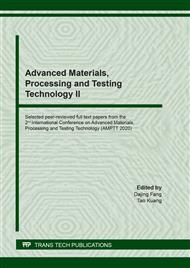[1]
W. Grzesik, T. Wanat, Surface finish generated in hard turning of quenched alloy steel parts using conventional and wiper ceramic inserts, Int. J. Mach. Tool. Manuf. 46 (2006) 1988-1995.
DOI: 10.1016/j.ijmachtools.2006.01.009
Google Scholar
[2]
H. Çalışkan, C. Kurbanoğlu, P. Panjan, M. Čekada, D. Kramar, Wear behavior and cutting performance of nanostructured hard coatings on cemented carbide cutting tools in hard milling, Tribol. Int. 62 (2013) 215-222.
DOI: 10.1016/j.triboint.2013.02.035
Google Scholar
[3]
P.S. Sreejith, B.K.A. Ngoi, Dry machining: machining of the future, J. Mater. Process. Technol. 101 (2000) 287–291.
DOI: 10.1016/s0924-0136(00)00445-3
Google Scholar
[4]
Khan AA, Mohiuddin AKM, Norhamzan NH (2018) A compara tive study on fank wear of ceramic and tungsten carbide inserts during high speed machining of stainless steel. Int J Appl Eng Res 13:2541–2544.
Google Scholar
[5]
Zeilmann RP, Fontanive F, Soares RM (2017) Wear mechanisms during dry and wet turning of Inconel 718 with ceramic tools. Int J Adv Manuf Technol 92:2705–2714.
DOI: 10.1007/s00170-017-0329-7
Google Scholar
[6]
Zerrouki V, Vigneau J, Dudzinski D, Devillez A, Moufki A, Larrouque D (2004) A review of developments towards dry and high speed machining of Inconel 718 alloy. Int J Mach Tools Manuf 44:439–456.
DOI: 10.1016/s0890-6955(03)00159-7
Google Scholar
[7]
A.S. Kumar, A.R. Durai, T. Sornakumar, Machinability of hardened steel using alumina based ceramic cutting tools, Int. J. Refract. Met. Hard Mater. 21 (2003) 109–117.
DOI: 10.1016/s0263-4368(03)00004-0
Google Scholar
[8]
A.S. Kumar, A.R. Durai, T. Sornakumar, The effffect of tool wear on tool life of alumina-based ceramic cutting tools while machining hardened martensitic stain less steel, J. Mater. Process. Technol. 173 (2006) 151–156.
DOI: 10.1016/j.jmatprotec.2005.11.012
Google Scholar
[9]
Y. Cheng, H.P. Hu, S.S. Sun, Z.B. Yin, Experimental study on the cutting performance of microwave sintered Al2O3/TiC ceramic tool in the machining of hardened steel, Int. J. Refract. Met. Hard Mater. 55 (2015) 39–46.
DOI: 10.1016/j.ijrmhm.2015.11.006
Google Scholar
[10]
A.S. Kumar, A.R. Durai, T. Sornakumar, Wear behaviour of alumina based ceramic cutting tools on machining steels, Tribol. Int. 39 (2006) 191–197.
DOI: 10.1016/j.triboint.2005.01.021
Google Scholar
[11]
G.S. Goindi, P. Sarkar, Dry machining: a step towards sustainable machining Challenges and future directions, J. Clean. Prod. 165 (2017) 1557–1571.
DOI: 10.1016/j.jclepro.2017.07.235
Google Scholar
[12]
Y.Q. Xing, J.X. Deng, et al., Cutting performance and wear mechanism of nanoscale and microscale textured Al2O3/TiC ceramic tools in dry cutting of hardened steel, Int J Refract Met Hard Mater 43 (2014) 46–58.
DOI: 10.1016/j.ijrmhm.2013.10.019
Google Scholar
[13]
K. Broniszewski, J. Wozniak, M. Kostecki, et al., Al2O3-V cutting tools for machining hardened stainless steel, Ceram. Int. 41 (2015) 14190–14196.
DOI: 10.1016/j.ceramint.2015.07.044
Google Scholar
[14]
W. Taha, S.A. Syed, F.M. Abul, et al., Design and development of ceramic-based composites with tailored properties for cutting tool inserts, Ceram. Int. 44 (2018)22421–22431.
DOI: 10.1016/j.ceramint.2018.09.009
Google Scholar
[15]
Xu CH, Wu GY, Xiao GC, Fang B. Al2O3/ (W, Ti)C/CaF2, multi - component graded self -lubricating ceramic cutting tool material. Int J Refract Metals Hard Mater. 2014; 45: 125–9.
DOI: 10.1016/j.ijrmhm.2014.04.006
Google Scholar
[16]
Yang X, Wang Z, Song P, Wang S, Wang Y, Mao K. Laminated structure optimization and drawing performance of Al2O3 - TiC/ Al2O3– TiC -CaF2, self-lubricating laminated ceramic conical die. Ceram Int. 2015;41(9):12480–9.
DOI: 10.1016/j.ceramint.2015.06.016
Google Scholar
[17]
Babul T, Baranowski M, Sobczak N, Homa M, Leśniewski W. Thermophysical properties of Cu - matrix composites manufactured using Cu powder coated with graphene. J Mater Eng Perform. 2016;25(8):3146–51.
DOI: 10.1007/s11665-016-2174-5
Google Scholar
[18]
Pakkirappa H, Mahesha K, Sachidananda KB. Vibration damping behavior and surface characterization of magneto-mechanical powder coated AISI304 stainless steel. Surf Coat Technol. 2017; 324: 382–9.
DOI: 10.1016/j.surfcoat.2017.06.005
Google Scholar
[19]
Wang X, Chen L, Jiao Y, Li J-L. Preparation of carbon fiber powder-coated Z-pins and experimental study on the mode I delamination toughening properties. Polym Compos. 2016; 37(12):3508–15.
DOI: 10.1002/pc.23550
Google Scholar
[20]
Wu G, Xu C, Xiao G, Yi M, Chen Z, Xu L. Self-lubricating ceramic cutting tool material with the addition of nickel coated CaF2, solid lubricant powders. Int J Refract Metals Hard Mater. 2016;56: 51–8.
DOI: 10.1016/j.ijrmhm.2015.12.003
Google Scholar
[21]
Yi M, Xu C, Chen Z, Wu G, Xiao G. Effect of nanosized CaF2 on mechanical properties of self-lubricating ceramic material. J Chin Ceram Soc. 2014;42(9):1127–33.
Google Scholar
[22]
D.W. Tan, W.M. Guo, H.J. Wang, et al., Cutting performance and wear mechanism of TiB2-B4C ceramic cutting tools in high speed turning of Ti6Al4V alloy, Ceram. Int. 44 (2018) 15495–15502.
DOI: 10.1016/j.ceramint.2018.05.209
Google Scholar
[23]
J.F. Zhao, Z.Q. Liu, B. Wang, et al., Cutting temperature measurement using an improved two-color infrared thermometer in turning Inconel 718 with whiskerreinforced ceramic tools, Ceram. Int. 44 (2018) 19002–19007.
DOI: 10.1016/j.ceramint.2018.07.142
Google Scholar
[24]
Y.S. Wang, B. Zou, C.Z. Huang, Tool wear mechanisms and micro-channels quality in micro-machining of Ti-6Al-4V alloy using the Ti(C7N3)-based cermet micro mills, Tribol. Int. 134 (2019) 60–76.
DOI: 10.1016/j.triboint.2019.01.030
Google Scholar
[25]
M. Armando, P.S. Mauro, F.S. Wisley, et al., Turning of Inconel 718 with whisker reinforced ceramic tools applying vegetable-based cutting fluid mixed with solid lubricants by MQL, J. Mater. Process. Technol. 266 (2019) 530–543.
DOI: 10.1016/j.jmatprotec.2018.11.032
Google Scholar
[26]
K. Aslantas, İ.U. Çicek, Tool life and wear mechanism of coated and uncoated Al2O3/TiCN mixed ceramic tools in turning hardened alloy steel, Wear 274275 (2012) 442–451.
DOI: 10.1016/j.wear.2011.11.010
Google Scholar
[27]
J. Zhao, X.L. Yuan, Y.H. Zhou, Cutting performance and failure mechanisms of an Al2O3/WC/TiC micro-nano-composite ceramic tool, Int J Refract Met Hard Mater 28 (2010) 330–337.
DOI: 10.1016/j.ijrmhm.2009.11.007
Google Scholar
[28]
C.H. Xu, F.M. Feng, R.B. Zhang, et al., Wear behavior of Al2O3/Ti(C, N)/SiC new ceramic tool material when machining tool steel and cast iron, J. Mater. Process. Technol. 209 (2009) 4633–4637.
DOI: 10.1016/j.jmatprotec.2008.10.017
Google Scholar
[29]
M. Kotkowiak, A. Piasecki, M. Kulka, The influence of solid lubricant on tribological properties of sintered Ni–20%CaF2 composite material, Ceramics International, Volume 45, Issue 14,2019, Pages 17103-17113.
DOI: 10.1016/j.ceramint.2019.05.262
Google Scholar
[30]
Jianxin Deng, Tongkun Cao,Self-lubricating mechanisms via the in situ formed tribofilm of sintered ceramics with CaF2 additions when sliding against hardened steel,International Journal of Refractory Metals and Hard Materials,Volume 25, Issue 2,2007,Pages 189-197.
DOI: 10.1016/j.ijrmhm.2006.04.010
Google Scholar



